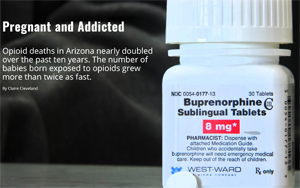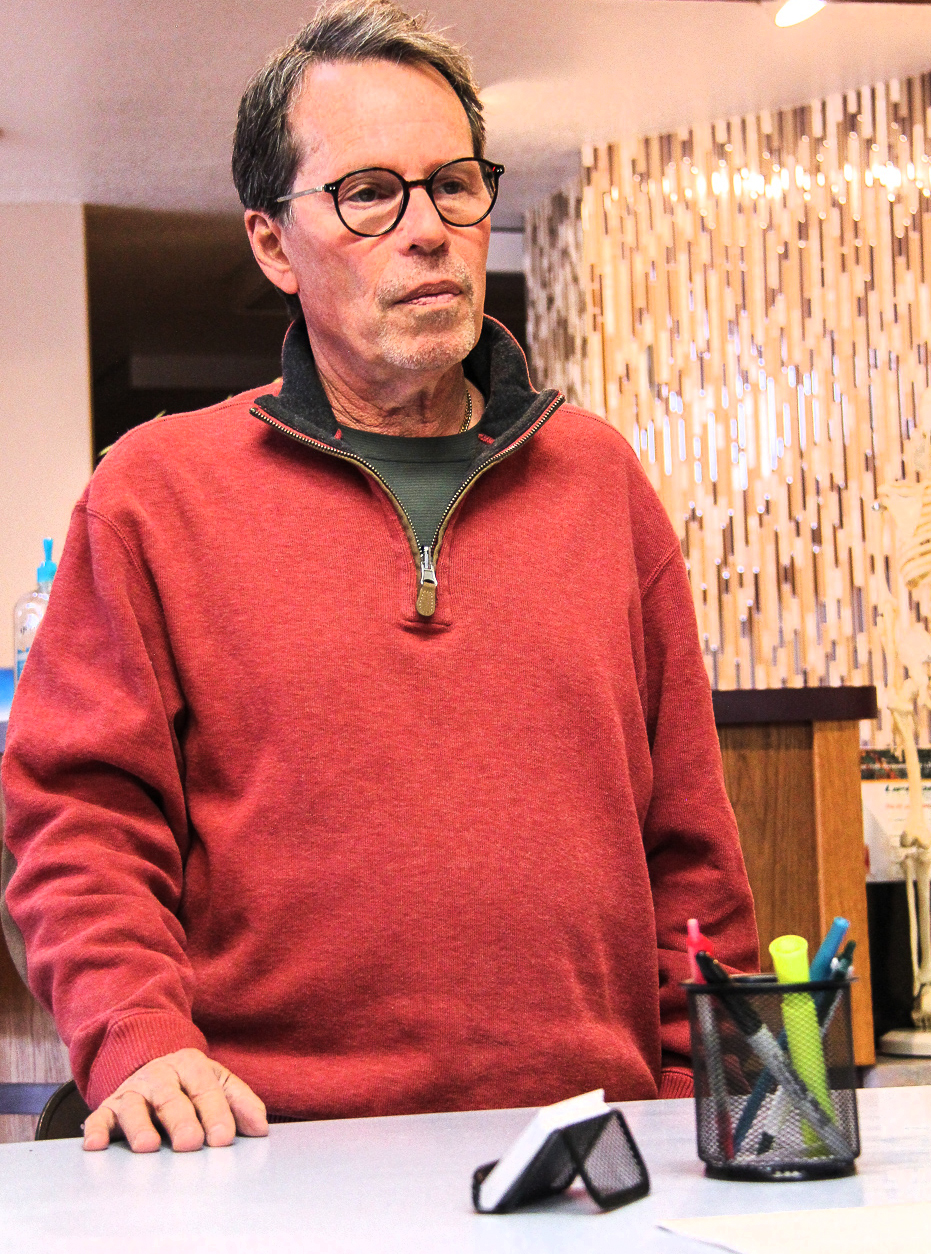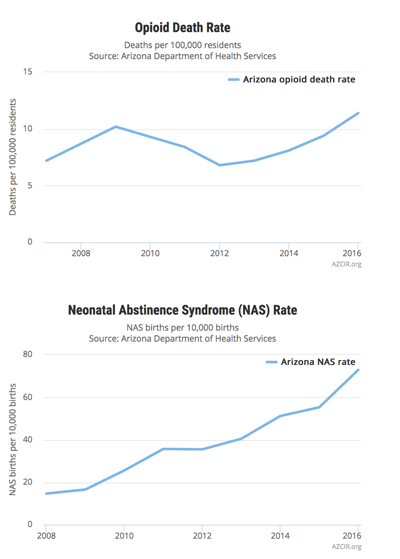Opioid deaths in Arizona nearly doubled over the past ten years. The number of babies born exposed to opioids grew more than twice as fast
By Claire Cleveland | Arizona Center for Investigative Reporting
 t the urging of Gov. Doug Ducey, Arizona lawmakers approved sweeping new regulations of opioids designed to curb the state’s sprawling opioid epidemic, which has seen overdose deaths nearly double in the past decade.
t the urging of Gov. Doug Ducey, Arizona lawmakers approved sweeping new regulations of opioids designed to curb the state’s sprawling opioid epidemic, which has seen overdose deaths nearly double in the past decade.
In 2016, the last complete year for which data is available, 790 Arizonans died of an opioid overdose.
But the drugs’ spread has been several times more dramatic for a small and vulnerable population that has few options for treatment: pregnant mothers and newborns. However, there is a chance that new funding tied to the reforms might be directed to help them.
In Arizona, the number of infants born with opioid withdrawal symptoms has increased almost five-fold during roughly the same period, going from 15 cases per 10,000 births in 2008, to 73 per 10,000 births in 2016.
 For most people addicted to opioids, quitting cold-turkey results in relapse more frequently than seeking treatment in a supervised detox program.
For most people addicted to opioids, quitting cold-turkey results in relapse more frequently than seeking treatment in a supervised detox program.
Recent research shows better outcomes result from a treatment known as medication-assisted treatment (MAT), in which a patient uses a replacement drug, such as methadone or buprenorphine, to wean off the opioid under medical supervision. For pregnant women addicted to opioids, a relapse compounds risks for both the mother and the unborn child, and researchers have been sharing best practices for administering MAT to them, as well.
Only about two in five pregnant women addicted to opioids in Arizona receive MAT, according to the most recent tracking by the Arizona Department of Health Services.
Opioid addiction is more prevalent in some parts of the state. Data collected by the Department of Health Services for the second half of 2017 show the overdose rate is highest in Graham County, a rural area in eastern Arizona, and Yavapai County, another rural county northwest of the Phoenix metro area.
There are few options for addicts to receive treatment in many rural parts of the state. Many live hours away from addiction recovery services, like detox programs and therapy.
The scarcity of programs is compounded for pregnant women in rural Arizona seeking medication assisted treatment because many doctors have not yet been educated about administering MAT to pregnant women.
Tara Sundem, co-founder of Hushabye Nursery, a nonprofit that advocates for best practices for infants suffering from prenatal drug exposure, said because doctors, especially in rural areas, may not have regularly treated pregnant women in need of MAT, some women have been referred to specialized treatment clinics in the urban centers of Phoenix or Tucson.
“For many obstetricians, especially in the neonatal world, it’s really kind of new for us,” Sundem said. “So, they would maybe see one or two a month, and now they’re seeing five a day.”
Methadone-based MAT requires daily visits to a clinic, where a medical professional administers the drug, because of federal regulations. But buprenorphine is less regulated, and can be prescribed so that someone can have a supply for days or weeks. Prescribers must determine the supply based on their assessment of the individual patient’s risk factors.
The more frequently a patient must visit a clinic, the greater the burden for people who have to travel long distances to visit the clinic. In rural areas, pregnant mothers can be left with limited options.
The problem is acutely felt in Gila County, a poor, sparsely populated area just east of the Phoenix metro area. Among the state’s 13 rural counties, Gila County has the highest rate of babies born suffering from opioid withdrawal, or neonatal abstinence syndrome (NAS), between 2008 and 2016, but only three providers that administer MAT.
Women who use prescription and illicit opioids while pregnant have a higher chance of giving birth to an infant with neonatal abstinence syndrome. The symptoms are similar to what an adult in withdraw would feel, but infants are not technically considered addicted, because they cannot show the same behavioral symptoms associated with addiction.

The symptoms of addiction in most people include withdrawal, but also a strong desire for opioids, inability to control or reduce use, continued use despite causing personal problems, increasing use and tolerance, and putting significant time and effort into obtaining and using opioids.
Infants with NAS typically have a lower than average birth weight, and they cry and shake uncontrollably. Other symptoms include restlessness, vomiting, not eating or sleeping properly and fever.
Studies show babies with NAS more frequently develop learning disabilities and ADHD, but researchers say they still have more to learn about the long-term effects.
Between 2008 and 2016, Gila County, with slightly more than 50,000 people, reported 53 infants per 10,000 births born with NAS, almost one and half times greater than the statewide rate of 38 infants per 10,000 births.
There are no methadone clinics in Gila County and only three buprenorphine providers, all are in Payson, a town of a little more than 15,000 people in the northern part of the county. The counties remaining 39,000 residents live in small towns scattered across the county.
“We have limited resources in Gila County,” Chuck Turney, Gila County Public Health Department drug prevention coordinator, said. “We don’t have long-term facilities here. Anybody doing long-term MAT therapy has to be transported out of the area.”
Gila County shares a border with Mesa, in neighboring Maricopa County, but Paula Horn, deputy director of Health & Emergency Management in Gila County, said that the resources in Mesa are often at least an hour away from Gila residents.
If residents don’t have access to a car, they are stuck, Horn said. Gila County has limited public transportation, Uber and taxi services. The state Medicaid program, the Arizona Health Care Cost Containment System, will set up transportation for enrollees, but requires up to 48-hour advance notice. Because the program requires frequent visits, managing the travel has prevented some patients from keeping with the program, Horn said. Some addicts continue using, relapse or even overdose during the 48-hour wait.
Marc Grant, a Doctor of Osteopathic Medicine, runs a small buprenorphine and pain management clinic in Payson – the most populous town in Gila County. The clinic is open three days a week, and has about 60 patients.
The lack of treatment options motivated Grant to move his practice to a more rural area like Payson, where he could make a bigger difference. But he said he knows there are more people who need MAT and therapy to conquer their addiction, as evidenced by his full caseload of patients.
“We need a lot more therapists,” he said.
In 2015, about 310 people visited the emergency room or were discharged from inpatient care for opioids in Gila County, according to ADHS data. A count of emergency room visits for opioids can give a sense of how many people in a given area are abusing opioids, but it likely under-represents the total, Turney said.
In 2017, Ducey issued an executive order instructing state law enforcement and public agencies to collect and share more overdose data, and an emergency declaration instructing law enforcement agencies and ambulances to carry naloxone, a life-saving drug that can be administered to someone overdosing.
The governor said the executive order will help public health officials “understand exactly what we’re facing in real time, allowing us to make the most informed choices with the resources at our disposal.”
Months after Ducey’s order, Horn and Turney said they believe hospitals in Gila County don’t always identify every case involving an opioid, meaning the actual rate could be significantly higher.

ACR.org“It’s going to be difficult to identify if hospitals are not tracking,” Horn said. “We also don’t know if the hospital is reporting effects of drugs such as heart palpitations, and using those as the primary diagnosis instead of the underlying drug issue.”
Gila County has two hospitals, Cobre Valley Regional Medical Center in Globe and Banner Payson Medical Center in Payson. Horn said the Gila County Health Department does not have the resources to send someone out to the hospitals to train them on using the electronic records system more effectively.
“There is still a huge learning curve for our hospitals here,” she added. “We’re asking the state to get someone out here to do training and explain how it is supposed to look. We need to see what kind of an issue we really have, because if you’re not collecting data, it’s pretty hard to know.”
Horn said having better tracking of where people addicted to opioids are will help the county assess what resources are needed, but that getting those resources will be difficult, because there’s not adequate funding to run the programs, and even if they get new funding, there are few providers who can administer them
Despite research that shows MAT reduces mortality among opioid abusers by half or more, researchers say the stigma of drug replacement has long held back this kind of rehabilitation treatment. As a result, access to MAT is scarce across the country. A 2016 report by the U.S. surgeon general found that only 10 percent of people with a drug use disorder get specialty treatment.
Maleah Woodward, program director for Southwest Behavior and Health Services in Yavapai County, said that for people who are addicted and live in rural areas, jobs, families or children can prevent them from making the trip to a clinic, leading many to drop out of the treatment program.
For women who are pregnant and addicted, MAT offers stability and better outcomes because the treatment is medically controlled, avoids the up-and-down cycle of using street drugs and eliminates other risks associated with illicit drug use. While methadone was the standard replacement drug for pregnant women, studies have shown buprenorphine is safer and more effective for pregnant women.
Women who get into an MAT program, then wean off the replacement drug, or find a dosage that will work long-term, are able to provide a more stable environment for their children, which can translate to better long term health, said Dr. Don Teater, a substance abuse specialist in North Carolina who works with the Centers for Disease Control and Prevention.
“I’ve seen MAT help someone from the worst point in their life, losing their families, homes, and jobs, to getting all of that back and being extremely successful,” Teater said. “So, I really see this medication as being part of the answer to this epidemic.”
MAT hasn’t been accepted as the only treatment approach, Teater said, and abstinence programs are still frequently used.
“Detox and abstinence-based treatment are primary in a lot of communities,” he said, “and a lot of people in the addiction field think that MAT is trading one addiction for another, but studies show that MAT is by far the most effective.”
MAT is effective because the replacement drugs, methadone and buprenorphine, are “pharmacologically long-acting.” That means a patient can take one pill in the morning and then feel normal for the rest of the day, Teater said, eliminating the need to seek out the drugs they were using before.
While Gila County’s need for addiction treatment outpaces what’s available, Prescott, the main population center in Yavapai County, northeast of the Phoenix metro area has become a national destination for addiction recovery. The city of 40,000 people has more than 200 group homes, but not many options for receiving MAT treatment.
For people in other parts of the county, which is about the size of Massachusetts, access to rehabilitation care is scarce.
Yavapai County has only one methadone center: Prescott Valley Opioid Replacement Services, operated by Southwest Behavioral and Health Services (SWBH).
SWBH also operates the only methadone treatment center in Coconino County and the only treatment center in Mohave County.
“Some of our clients live an hour away from our site, some live an hour-and-a-half away,” Woodward, the program director for Yavapai County SWBH, said.
For clients who can get to the clinic, Woodward said the stigma is a major impediment, leaving some expecting mothers resistant to using MAT, or causing them not to return for ongoing treatment.
“There’s very much the 12 step kind of attitude, of you’re not really sober or in recovery if you’re on medication to be sober,” Woodward said. “So, some women and clients in general walk in with that concern and stigma in their mind.”
Reaching women who live in more isolated areas, to let them even know services are available, can be challenging.
Yavapai County Community Health Services (YCCHS) is the regional health department for the area. One of its programs, Health Start, pairs pregnant teens and women with community health workers who are mothers themselves.
The Health Start counselors help mothers get access to medical and social services. They help with finding a doctor for prenatal care, applying for AHCCCS, the state’s Medicaid program, and WIC, a service specifically for low-income pregnant women and recent mothers. They can also help women find county-administered or charitable social services. Typically, they travel to pregnant mothers’ homes to provide the services. While there, if they see signs of drug abuse, they can help the women get into a program earlier, which has been shown to decrease risks.
“We’re seeing pregnant, high-risk moms in the community, who are low-income and non-English-speaking. The majority are moms with little resources,” said Stacey Gagnon, Maternal Child Health Section manager at YCCHS. “We provide information on baby care, feeding tips and sleeping tips. It’s your mother coming to your house and telling you how to do this.”
Gagnon said early detection and getting women into a program decreases the risk that the pregnant women end up arrested or jailed for drug-related crimes.
For those women who do not seek treatment and are not intercepted by state or county programs, jail is a common place for them to detox and discover that they’re pregnant, Gagnon said.
A 2016 report released by the Vera Institute of Justice and the Safety and Justice Challenge, two charitable organizations, showed that women make up the fastest-growing jailed population, and that 82 percent of women in jail have experienced drug or alcohol abuse or dependency.
Gagnon also administers a new county pilot program, where she visits pregnant female inmates at the Camp Verde Jail to educate them on what their birth experience in jail will be like, and to help get them resources when they’re released.
“Every pregnant woman we’ve talked to, their biggest fear is delivering in the jail and being shackled,” Gagnon said. “It’s inhumane to restrain them. It’s barbaric. Especially when they have no history of violence. Mostly drugs and theft. How violent could they possibly be?”
The Camp Verde Jail does not have MAT licensing to provide methadone to its inmates. If the jail has a pregnant and addicted inmate, she can be transferred to the Maricopa County Corrections system, where MAT is available.
In 2016, there were 21,667 female inmates in Maricopa County. Of those, 735 women were pregnant. While the vast majority of pregnant inmates end up being released before giving birth, ten babies were delivered to incarcerated moms. That year, 89 pregnant women received opioid treatment in the form of methadone.
It took the Maricopa County Sheriff’s Office years to get everything in order to get the licensing and MAT on site. Smaller county jails may not have the resources he was able to spend on implementing the system, said Jeffrey Alvarez, MCSO’s correctional health services medical director.
In Payson, Grant recently decided to open up his practice to AHCCCS patients, who make up a large portion of the substance abuse population.
“We’ve just started the paperwork and turned it into the state,” Grant said. “There’s not much in the way of access, so I thought I would make myself more available, especially since there is such a need.”
However, Grant intends to retire in the next five years. He’s been practicing medicine since the 1970s and drives nearly an hour to work. His retirement could leave even more addicts struggling in the area with severely limited options.
The legislation signed into law this week contains a variety of measures affecting regulation of opioids and prescribers, criminal justice procedures, and funding for new programs. The sweeping bill also allows more doctors to provide MAT treatment.
Christina Corieri, a policy advisor to Gov. Ducey, said some provisions may help provide more access to treatment for pregnant mothers addicted to opioids.
Specifically, the Department of Health Services will collect new quarterly reports on out-patient provider capacity, which will help track where MAT treatment needs are greatest. Previously, only in-patient capacity was tracked.
A one-time $10M appropriation to AHCCCS will also help cover costs for some low-income patients who do not currently qualify for Medicaid coverage. AHCCCS Chief Medical Officer Sara Salek said the agency will soon formally consider how to best use the funding infusion, but that it could add to programs specifically designed to help get new clinics running in areas with higher needs.
The new law also requires medical students to receive opioid-related clinical education, which, Corieri said, will complement 2017 legislation that expanded student loan forgiveness for newly-graduated providers who spend at least two years in rural areas of the state.
The bill also incentivizes some clinics to offer expanded hours of operation.
All of those together, Corieri said, should help more pregnant women get access to MAT.
Sundem, of Hushabye Nursery, said the most important thing that could happen would be reducing any barrier women might have to getting the treatment that can help them turn their lives around and provide stability for the newborn.











